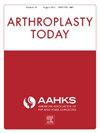基于整合大注册表数据的无骨水泥髋关节置换术干型的性能。
IF 1.5
Q3 ORTHOPEDICS
引用次数: 0
摘要
背景:无骨水泥全髋关节置换术的改进旨在优化股骨植入物的骨整合以减少无菌性松动率。干设计在这些植入物的性能中起着关键作用。鉴于新系统设计的增加和更新分类系统的创建,有必要改进对每种系统类型结果的理解。本研究的目的是确定基于茎设计和专有模型的总体修改率。方法:从美国关节置换注册中心(2021年)、英国国家联合注册中心(2021年)、新西兰联合注册中心(2020年)和澳大利亚骨科协会国家关节置换注册中心(2021年)的年度报告中收集报告总体病例的联合注册数据和每个无水泥茎品牌的修订数据。根据Radaelli等人描述的分类系统,将每个单独的茎品牌划分为茎类型。结果:利用最多的茎类型是(1)B2型茎,(2)a型茎和(3)C1型茎。使用最多的茎模型是(1)Corail茎(B2), (2) Accolade II (A型)和(3)Taperloc 133 (A型)。总体修正率最高和最低的是B1型茎(8.09%)和C3型茎(1.12%)。总体修正率最高的3个主干模型分别是Synergy HA主干(9.04%)、CBC主干(8.59%)和CLS主干(7.96%)。总体翻修率最低的3个茎分别是C2茎(0.00%,933例中有0例)、Actis Duofix(0.59%)和VerSys茎(0.89%)。结论:基于合并的大型注册数据,在基于茎设计的比较中,一些无骨水泥的股骨干类型和模型似乎比其他类型和模型表现更好。本文章由计算机程序翻译,如有差异,请以英文原文为准。
Performance of Cementless Hip Arthroplasty Stem Types Based on Consolidated Large Registry Data
Background
Improvements in cementless total hip arthroplasty have been directed at optimizing osseointegration of the femoral implant to reduce aseptic loosening rates. Stem design plays a critical role in the performance of these implants. Given the increase in new stem designs and the creation of an updated classification system, improved understanding of the outcomes of each stem type is warranted. The purpose of this study was to determine overall revision rates based on stem design and proprietary model.
Methods
Joint registry data on the reported overall cases and revisions for each cementless stem brand were collected from the annual reports of the American Joint Replacement Registry (2021), United Kingdom National Joint Registry (2021), New Zealand Joint Registry (2020), and Australian Orthopaedic Association National Joint Replacement Registry (2021). Each individual stem brand was classified into a stem type derived from the classification system described by Radaelli et al.
Results
The most utilized stem types were (1) type B2 stems, (2) type A stems, and (3) type C1 stems. The most utilized stem models were the (1) Corail stem (B2), (2) Accolade II (type A), and (3) Taperloc 133 (type A). The highest and lowest overall revision rates observed were in the type B1 stems (8.09%) and type C3 stems (1.12%), respectively. The 3 stem models with the highest overall revision rates were the Synergy HA stem (9.04%), CBC stem (8.59%), and CLS stem (7.96%). The 3 stems with the lowest respective overall revision rates were the C2 stem (0.00%, 0 of 933 cases), Actis Duofix (0.59%), and VerSys stem (0.89%).
Conclusions
Based on consolidated large registry data, some cementless femoral stem types and models appear to perform better than others when compared on the basis of stem design.
求助全文
通过发布文献求助,成功后即可免费获取论文全文。
去求助
来源期刊

Arthroplasty Today
Medicine-Surgery
CiteScore
2.90
自引率
0.00%
发文量
258
审稿时长
40 weeks
期刊介绍:
Arthroplasty Today is a companion journal to the Journal of Arthroplasty. The journal Arthroplasty Today brings together the clinical and scientific foundations for joint replacement of the hip and knee in an open-access, online format. Arthroplasty Today solicits manuscripts of the highest quality from all areas of scientific endeavor that relate to joint replacement or the treatment of its complications, including those dealing with patient outcomes, economic and policy issues, prosthetic design, biomechanics, biomaterials, and biologic response to arthroplasty. The journal focuses on case reports. It is the purpose of Arthroplasty Today to present material to practicing orthopaedic surgeons that will keep them abreast of developments in the field, prove useful in the care of patients, and aid in understanding the scientific foundation of this subspecialty area of joint replacement. The international members of the Editorial Board provide a worldwide perspective for the journal''s area of interest. Their participation ensures that each issue of Arthroplasty Today provides the reader with timely, peer-reviewed articles of the highest quality.
 求助内容:
求助内容: 应助结果提醒方式:
应助结果提醒方式:


